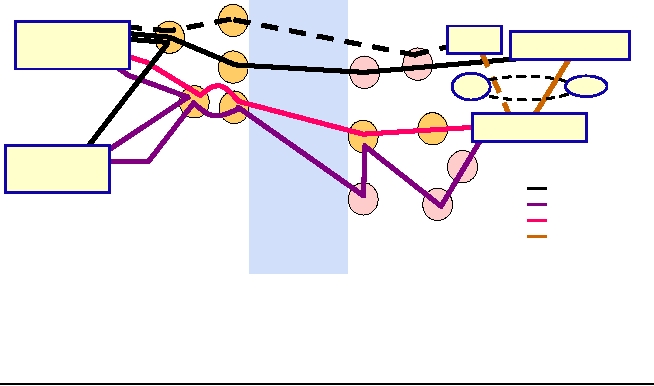parts (power supplies, supervisors, etc). Also great care has been taken when selecting the
providers for international connectivity to make sure the circuit paths are physically diverse. The
three US LHCNet transatlantic circuits use three different transatlantic cables as shown in Figure
14. The fourth transatlantic circuit (expected to be installed in spring 2008) will provide even
more redundancy across the Atlantic, and the new segment Geneva-London will provide more
path diversity in the Geneva area as well.
US LHCNet provides a reliable network service to CERN and to the US Tier1s, BNL and FNAL.
Although US LHCNet has the capability of offering a virtual circuit or a routed (IP) service, its
highest priority function is as a circuit provider for the LHC OPN. Today we rely on the rapid
spanning tree protocol (RSTP) for recovery from a circuit failure and selection of an alternate
path, but in the future this will be done at the optical level using the circuit restoration capabilities
of the Ciena CoreDirector CI. We are also exploring the possibility of using transatlantic circuits
from other R&E networks in the case of a link outage. Today we fall back to a routed ESNET-
GEANT2 service if the US LHCNet circuits become unavailable.
NYC
Brookhaven
111 8th
AC-1
NYC-
Whitesands
LON
AMS-SARA
Bellport
MANLAN
AC-2
EAST
WEST
Bude
VSNL
North
VSNL
Frankfurt
Highbridge
GVA-CERN
Wal,
NY
60 Hudson NJ
VS
NL
CHI-
So
uth
Starlight
Global Crossing
Paris
Qwest
Atlantic
Colt
Pottington
London
(UK)
Ocean
GEANT
Figure 14: US LHCNet Transatlantic Cable Paths
Working Methodology - Production and "High-Impact"
Networking:
The US LHCNet backbone is architected and operated to guarantee 24x7x365 network
availability and full performance, supporting both large-scale data transfers and real-time traffic
such as that from VRVS/EVO. Our team works closely with the CMS and ATLAS software and
computing projects, to make the network and its mode of use evolve according to the needs of the
LHC experiments, and to consistently meet the particular needs of the U.S. physics groups. We
keep the US LHCNet bandwidth and technology in line with the ESnet backbone, thereby
providing U.S. researchers with adequate networking, and potentially a competitive advantage for
their research.
Our working methodology, which has been very successful over the last 10 and especially the last
5 years, is illustrated in Figure 15 . While our primary focus is the operation of the production
network, with the rapid advance of network technologies (and the associated requirements-
evolution) year-by-year there is a necessary continuing process of "Experimental" network
development, where the production networks of any given year are prepared in the previous one
37

